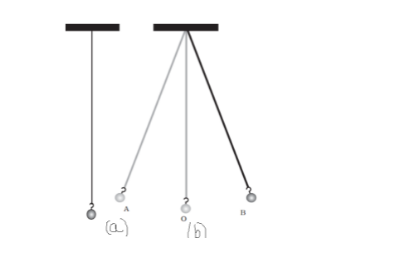One of the most frequent items seen in most households is a pendulum. It’s a component typically found in wall clocks. The purpose of this article is to provide information about this item and how it works.
A simple pendulum is made of a heavy point mass (bob) hung from a rigid support by a massless and inextensible thread. The pendulum is started in motion when the bob is pulled to one side and then released, and the bob moves alternately on either side of its mean position.
A pendulum is nothing but a weight suspended from a fixed point. It is positioned in such a way that the device can easily swing back and forth. A simple pendulum’s bob is viewed as a point mass. Furthermore, the string from which it hangs is extremely light or has no mass.
Terms Related to Simple Pendulum
Oscillation: An oscillation is a complete to and fro motion of the pendulum.
Time period: This is the amount of time it takes for one oscillation to finish.
Frequency of Oscillation: This is the number of oscillations per second.
Effective length of Pendulum: It is the distance between the points of oscillation (i.e. the bob’s center of gravity) from the point of suspension.
Construction and Working of Simple
Construction
A simple pendulum is made out of a small metallic ball or a fragment of stone hung by a thread from a strong platform. The bob is a pendulum with a metallic ball attached to it.
Working

The pendulum is shown in its mean position in Fig (a). When the pendulum’s bob is released after being swung slightly to one side, it begins to swing back and forth [Fig (b)]. A simple pendulum’s to and fro oscillation is an example of a periodic or oscillatory motion.
When the pendulum’s bob goes from its mean position O to A, B, and back to O, it is considered to have completed one oscillation.
When the bob moves from one extreme position A to the other extreme position B and then back to A, the pendulum completes one oscillation.
Time period of a Simple Pendulum
Generally Time Period is the amount of time a pendulum takes for one oscillation to finish.
It’s important to note that the oscillation of a simple pendulum can only displays a simple harmonic motion if the oscillation is small or the amplitude of the oscillation is very small compared to two lengths of string, so the motion of a simple pendulum is considered simple harmonic motion using a small angle approximation.
The pendulum begins a periodic motion when the bob is shifted to a particular angle, and the periodic motion is a simple harmonic motion with angular displacement of the bob for small values of the displacement angle.
F=-mgsinθ
And
a=-gsinθ
Let us Consider is small for the small oscillation
Therefore,
sinθ=θ=x/l
After Putting this value in a, we get
a=-gθ
a=-gx/l
a=−ω²/x
Hence, the Angular Frequency is =2Π/T
ω=√g/l
And as we know that
T=2π/ω
Now after Substitution we get:
T=2πlg
So, based on the equation for the simple pendulum’s time period, we may deduce that the time period is independent of the pendulum’s mass and does not change with changes in the small amplitude of oscillation. It is entirely determined by the length of the string and the rate of acceleration. It has been commonly used to track a fixed interval of time because to this property.
Application of Simple Pendulum
Clock
A pendulum is used in a mechanical clock to keep correct time. The period of a pendulum swing is determined by the force of gravity and the length of the pendulum.
The pendulum’s arm connects to a device that powers a gear system at its top end. The clock’s hands are driven by the gears. Friction causes a small amount of the pendulum’s motion to be lost; this is corrected by a wind-up spring or weights.
Wrecking Pendulum
A wrecking ball, which is used to demolish structures, is another example of pendulum motion. On a sturdy cable, a skilled crane operator swings the wrecking ball at the building to be demolished. The upswing stores energy, which is released when the ball strikes something.
Bowling Ball
Bowling’s swinging action also demonstrates how a pendulum’s partial swing stores energy. On the backswing, you store energy in your arm and the ball. It’s the effect of the ball’s weight being lifted against gravity.
When you let go of the ball, the energy is released, and the ball moves ahead into the bowling alley.
Ballistic Pendulum
A ballistic pendulum is a big block of wood suspended from ropes that has been used by police departments for many years. The wood’s mass is exactly known. A bullet is fired into the block by a technician. It is started in motion when the bullet lodges in it.
The bullet’s momentum and energy are measured at the farthest point of its backward swing. Given the bullet’s mass, the technician can estimate the bullet’s velocity.
Metronome
A mechanical metronome maintains musical time by swinging a pendulum. It has a sturdy arm with an adjustable bob that slides up and down.
When compared to a clock pendulum, it’s arranged backwards; the swing period is longest when the bob is at its highest point.
Conclusion
In this article we are studying about a simple pendulum and its uses or applications. A simple pendulum is composed of a mass m suspended from a string with a length L and a pivot point P. When the pendulum is shifted to an initial angle and released, it will swing back and forth in a regular pattern and this is the working principle of a simple pendulum.
 Profile
Profile Settings
Settings Refer your friends
Refer your friends Sign out
Sign out






